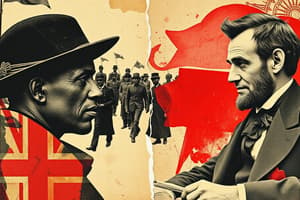Podcast
Questions and Answers
What was the main legal argument used by Chief Justice Taney in the Dred Scott v. Sanford case?
What was the main legal argument used by Chief Justice Taney in the Dred Scott v. Sanford case?
- Enslaved individuals can petition for their freedom in court.
- The rights of enslaved individuals are protected by the Constitution.
- Scott was considered property regardless of his residence. (correct)
- States have the right to regulate their own slavery policies.
Which of the following events directly followed the election of Abraham Lincoln in 1860?
Which of the following events directly followed the election of Abraham Lincoln in 1860?
- The federal government intervened in local elections.
- South Carolina seceded from the Union. (correct)
- The signing of the Emancipation Proclamation.
- Abolition of slavery in the northern states.
What was John Brown's objective in leading the raid at Harpers Ferry?
What was John Brown's objective in leading the raid at Harpers Ferry?
- To negotiate for the rights of enslaved people.
- To create a new abolitionist political party.
- To establish a safe haven for runaway slaves.
- To capture a federal arsenal and incite a slave revolt. (correct)
Which argument did Southern states use to justify their secession from the Union?
Which argument did Southern states use to justify their secession from the Union?
What was the immediate consequence of the Confederate attack on Fort Sumter?
What was the immediate consequence of the Confederate attack on Fort Sumter?
What was the main stipulation of the Missouri Compromise regarding the status of states based on their geographic location?
What was the main stipulation of the Missouri Compromise regarding the status of states based on their geographic location?
What was the purpose of the Wilmot Proviso?
What was the purpose of the Wilmot Proviso?
What did the Compromise of 1850 entail regarding California's statehood?
What did the Compromise of 1850 entail regarding California's statehood?
What was one outcome of the Fugitive Slave Act included in the Compromise of 1850?
What was one outcome of the Fugitive Slave Act included in the Compromise of 1850?
How did the Kansas-Nebraska Act impact the status of slavery in the territories?
How did the Kansas-Nebraska Act impact the status of slavery in the territories?
What was the primary consequence of the tensions caused by slavery in Kansas?
What was the primary consequence of the tensions caused by slavery in Kansas?
What political party emerged in response to the divisions over slavery in new territories?
What political party emerged in response to the divisions over slavery in new territories?
Who won the presidential election in 1856 and was a member of the Democratic Party?
Who won the presidential election in 1856 and was a member of the Democratic Party?
Flashcards are hidden until you start studying
Study Notes
The Search for Compromise
- The issue of slavery sparked long-standing debates and conflicts in the United States.
- The Missouri Compromise established a boundary at the 36º 30’ line, designating states north as free and south as slave-holding.
- The Wilmot Proviso aimed to ban slavery in territories acquired from Mexico, igniting Southern opposition desiring slavery in California and New Mexico.
- California's statehood application threatened the balance of power between free and slave states, with Southern states threatening secession.
- The Compromise of 1850, proposed by Senator Henry Clay, included California as a free state while leaving new territories open to slavery and enforcing stronger fugitive laws.
- The Fugitive Slave Act penalized anyone aiding escaped slaves, leading to Northern resistance through jury nullifications and Underground Railroad support.
- Franklin Pierce’s presidency (1853) aimed to enforce the Fugitive Slave Act.
- The Kansas-Nebraska Act allowed Kansas and Nebraska to decide the slavery issue locally, contradicting the Missouri Compromise and sparking violent conflicts termed “Bleeding Kansas.”
Challenges to Slavery
- The Republican Party emerged in opposition to slavery in new territories.
- James Buchanan, a Democrat, won the 1856 presidential election amidst deepening divisions over slavery.
- The Dred Scott v. Sanford case determined that enslaved Scott remained property regardless of the state, asserting constitutional protection for slavery and inciting outrage among anti-slavery advocates.
- Abraham Lincoln's debates with Stephen A. Douglas in 1858 elevated his national profile despite losing the Senate race.
- Abolitionist John Brown's raid on Harpers Ferry aimed to incite a slave revolt, threatening national stability.
Secession and War
- Abraham Lincoln was elected president in 1860, hoping to prevent Southern secession and the Civil War.
- South Carolina seceded from the Union on December 20, 1860, followed by several other Southern states forming the Confederate States of America.
- The Confederacy elected Jefferson Davis as its president, framing the secession in terms of states' rights and perceived contract violations by the federal government.
- Conflict erupted on April 12, 1861, when Confederate forces attacked Fort Sumter, marking the beginning of the Civil War as additional Southern states joined the Confederacy.
Studying That Suits You
Use AI to generate personalized quizzes and flashcards to suit your learning preferences.




